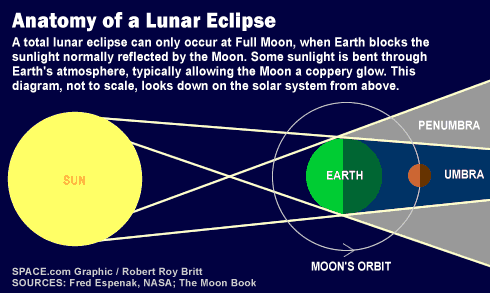A lunar eclipse is an event during which Earth’s shadow prevents the sunlight from reaching the moon. When an eclipse occurs, the moon usually remains visible, but has a dusky red or coppery color, which results when Earth’s atmosphere bends some sunlight-mostly longer red wavelengths-into the umbra. A total lunar eclipse occurs when the moon is fully within Earth’s umbra. A partial lunar eclipse occurs when only a portion of the moon is in Earth’s umbra. (Spaulding, & Namowitz, 2003)
In addition, there are some interesting facts about lunar eclipse. A lunar eclipse can occur only at the full moon phase, but it does not happen every month like the full month does, because there are 5 degrees angle between the plane of Earth’s orbit and the plane of the moon’s orbit. When the eclipse happens, if a person is on the moon, he would see the Earth blocks out the Sun. Earth would be ringed by light scattered through its atmosphere. (Britt, 2004) Moreover, the maximum time a lunar eclipse can last is 3 hours and 40 minutes, and lunar eclipses can occur up to 3 times a year. (Khan, 2008)
Reference:
Britt, RB. (2004, May). 10 cool facts about the lunar eclipse . Retrieved from http://www.msnbc.msn.com/id/3404517/ns/technology_and_science-space/
Khan, RK. (2008, April). Some interesting facts about lunar eclipse. Retrieved from http://www.indiastudychannel.com/resources/14637-Some-interesting-Facts-about-Lunar-Eclipse.aspx
Spaulding, NS, & Namowitz, SN. (2003). Earth science. Evanston, Lllinois: McDougal Littell

